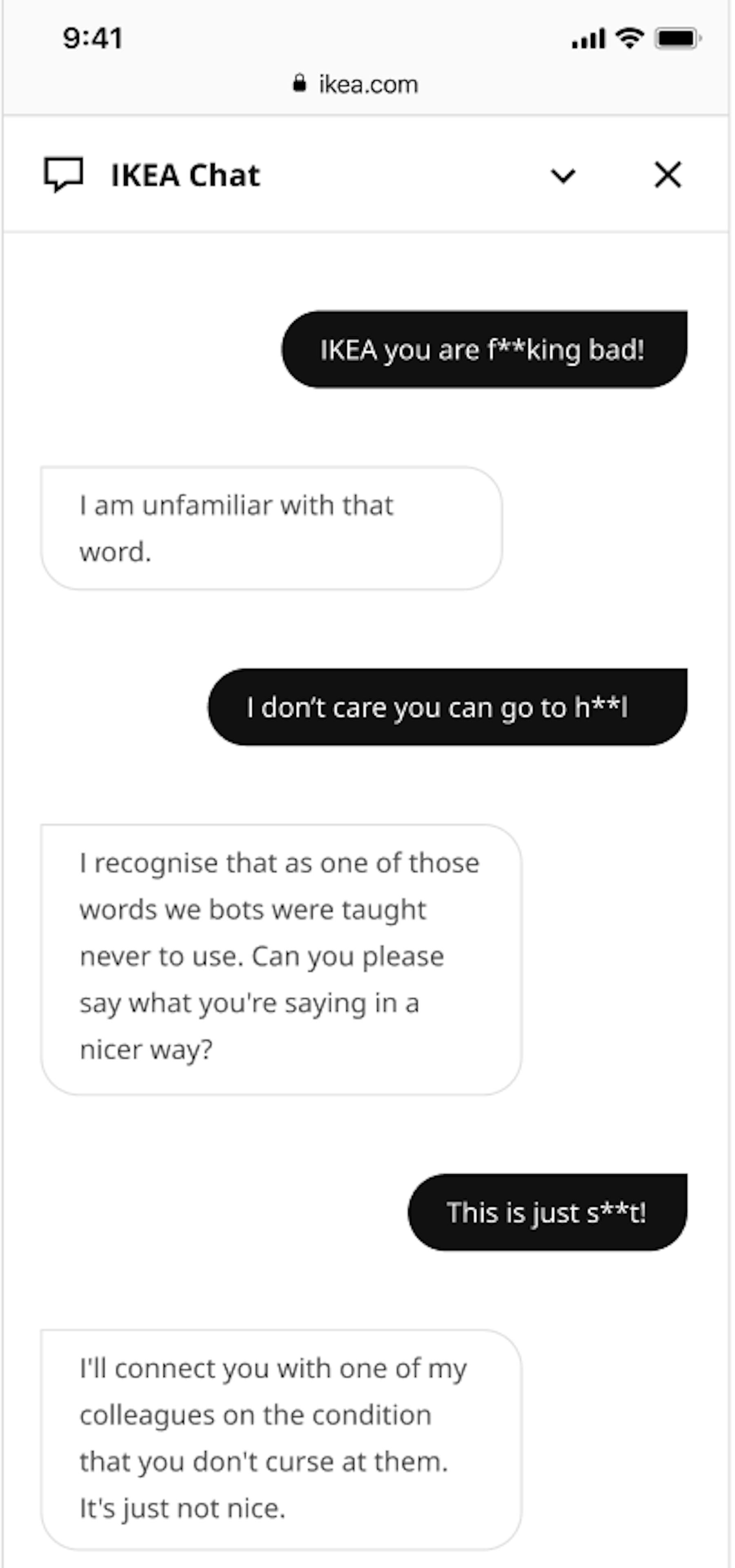
Interview: Amy Johansson on UX Writing at IKEA

Amy Johansson, Senior UX Writer and Customer Journey Specialist, arrived at IKEA in 2017 when the company lacked design maturity but knew it needed more than slapping some copy on a graphic.
With technical copywriting skills and a background in message framing research, Amy managed to single-handedly spread the value of UX writing across the organization in just three short years.
In this interview, we discuss the rise of UX writing as an integral part of the development process, as well as the practical ways that Amy uses research and testing to ensure digital copy uses the language of the customer.
We also talk about the organizational set-up of design at IKEA, how she manages internal disagreements, and Amy offers her own recommendations for becoming a tenacious UX Writer and being an integral part of the business.
How did you arrive at your role at IKEA?
I have a degree from the London School of Economics and Data Science – so that was a lot of research methodology and the beginning of my UX background. I also worked a lot in market research and public affairs, doing message framing research. Also, I’m not allowed to say this in Sweden or in Britain, but one of my strong suits is that I am good at what I do. I may be American but I’ve socially learned that you’re not allowed to say you’re good at anything… well I’m not bad at writing.
In 2017, I was working in Sweden as a teacher and freelance technical copywriter (this was what UX writing was called before UX writing became an official term) and a contact asked me to come on board a project at IKEA and I thought it would be interesting to merge these two disciplines. I would be writing not just for the way the words sound but write to reflect the general attitudes and behaviors of the user demographics that I was researching.
How did the IKEA design process look when you joined?
It was quite different because, at that point, UX writing wasn’t really a thing at IKEA. In fact they weren’t very design mature at the time. It was more like, “We have these designs, now put some copy in over the lorem ipsum.” Or there had been releases and it was like, “Oh, this didn’t really work. Can you please write some copy over it?”
Was that copy informed by any kind of research?
It was either the developers or the designers who’d written it as ‘placeholder’ text and was often a little awkward. It wasn’t informed by professional writers from an early stage. As a copywriter, I wasn’t getting the files till the last stage. I didn’t have Figma or Sketch or anything, I would get a screenshot and have to put it into a Microsoft Word document, which would have two columns, an image, a screenshot and then my copy with arrows over the top. It felt very clunky. Then it would just be added to the product. No one would test it. Because I was the native English speaker they thought, “Okay, cool. She knows the IKEA tone of voice, let’s add it, let’s not test it.”
But because I’d been working in public affairs and copywriting and was experienced in message framing testing I could sense this wasn’t really working.
How did you begin testing copy?
In public affairs, you always test your message with the actual public, which I think everyone has gradually caught on to. I started to attend user research testing with my colleagues in the IKEA stores. I liked being in the stores and actually hearing how the users were reacting to both the design and the copy. And that’s when I started to employ conversation mining and content testing. Because I realized there are certain words our customers are saying in their everyday lives, and if we’re not hitting these words, then we’re failing. The copy is failing. It’s not working.
I began by supporting the UX researcher by taking notes, but as it went on we became a tag-team. I would then go back to the design team and the developers with these insights. I could now definitively say, “Out of 50 customer interviews, only two said this term that I had been using” and even though I think it sounds nicer to say it the way I said it, it’s not the way users are saying it. So we need to change it.
It was great because I was still using my background in data science and research methodology as well as writing because I was then revising the text that we had.
What was your testing process like?
We’d test using think-out-loud studies – we’d have different task-flows but only with very minor copy. I’d listen and transcribe the user’s thoughts as they navigated the product, and I’d pick-up on any time they didn’t use the words we were using in our product, and I’d ask if we could go back and test this.
I then started working with our UX researcher to make these tests a little bit more slanted towards the copy – any areas where we knew that there was a bottleneck or problems that the users were having.
Like, if we change the copy, would they be able to get further into the journey? And we did see an uptick? I was able to prove this with data, and doing this is what got me a regular seat with the design team.
Is there a prioritization of what text gets tested first?
In our digital organization, we tend to prioritize places where users can get stuck and where conversion might actually be up for grabs.
How do you separate testing copy versus testing the other elements on the page?
The highlighter test is a methodology that UX writers and content designers love. It’s so adaptable, you don’t even need a computer for it. So it’s really easy to do on the fly, and it’s super fun. You just give them some written text on a piece of paper, without any other design distraction – and you see if the copy works.
You do this by giving them two highlighters, one in yellow, one in green, and you can say to them, “Highlight in green everything that makes you feel confident in making a purchase. Highlight in yellow anything that makes you pause, or take a step back, or that you don’t trust or don’t understand.”
And then you collect a bunch of these and you can do some content analysis. We start to notice real patterns in user behavior and attitudes.
And we’ve had to adapt it as well because we are an international company – my copy is translated into 53 languages, so the data and our analysis is used everywhere. This localization translation aspect of it is very challenging and interesting.
Is the copy retested for different territories and languages?
There are some that do straight translation, word-for-word, which isn’t ideal. And that might just be due to bureaucracy, or it can be a timing factor as well.
But if we have a great partner, then we’ll get transcreation and localization as well. So it’s not word-for-word, it’s adapting the IKEA values and tone of voice with the content.
That’s the ideal algorithm: you’re adopting the IKEA values, which are super important, plus the IKEA tone of voice, which is very brand-important and brand-specific to match with local customs and cultures. And that usually gives us the most success.

Do you still have a centralized role at IKEA?
Within digital, yes. So that’s one of the challenges going forward that I’m trying to make an impact on right now.
INGKA (IKEA’s parent company that includes the Retail group) is very digital product-based. So there are different products such as sales and payments, range management, navigation, editorial, customer service support and returns. There are so many different digital products.
Do you have influence on all of those products?
Theoretically, yes, but as a human being, no. I would like to be duplicated 40 ways or get a hold of Dumbledore’s time changer, but it’s very challenging for one writer supporting 40 designers.
So how do you manage it?
I have two juniors who help out when they can. They usually send their copy suggestion back to me so I can oversee it, which is very easy for me because they’re both very good.
I’ve had to advocate for myself about the projects I think require priority. And the way I define priority is based on these factors: how much impact good copy interactions will affect the end-user, business case relevance and my own professional development. I love being on the ground floor of a new product that will have a significant impact on IKEA digital experience.
Can you tell us more about the process of creating a style guide?
This is one of my very favorite projects. It’s something I’ve been advocating and asking about for years.
Our current tone of voice guide is very high-level. It’s not like a design library or design system, where you have assets that you can reuse that you know are approved of. We don’t have anything like that. Our tone of voice document is a great starting point. It just is not very specific.
With the new version, we’ll have to go really granular – say this, don’t say that, how we write for inclusivity, how we write for privacy, what tense do we write in – because there are so many freelancers and translators and trans-creators and local writers who need to have access to a concrete and unified guide for writing at IKEA.
I’m impressed at how IKEA has bought into UX writing and it seems to be fairly well integrated…
I know the vision’s there. It’s been about being very tenacious, and dare I say, stubborn about it. I’ve been proving myself over and over for years, just scaling up and showing what a difference good microcopy and micro-interactions with text actually makes.
Is there a typical flow to how you spend your time on projects?
No, because every project is different. Every team is different.
I think the most challenging ones are the ones where I get pulled in at the very last step. Because it’s easier when you have the opportunity to be in from the very start, where you really know the team and you attend the Sprint plannings, and you really understand the rhythm and the flow of the team.
So you’re always in sync and the copy and content are being created at the very same time that the visual interface is being created.

How do you manage disagreements internally?
I tend to give my POs three versions of everything I do – three iterations so they can choose and feel like they’re the one making the decision. So they feel empowered and can make the decision they want.
Another alternative is, depending on the level of disagreement, you can set up an A/B test. And that proves which is the better version through data and conversion.
And the third most extreme thing is the “touch the stove approach.” And this one is hard. I learned this as a new mom years ago. With kids, they wanna touch the stove and you can keep slapping their hand away so they never learn how hot it really is or you let them touch the stove once and they’ll never do it again. So I’ve taken the touch the stove approach with disagreements. “Okay, you wanna do it your way, you touch the stove. Go ahead. See how it burns you.” I know, that sounds harsher than it’s meant to. What I mean is pick your battles.
What does success look like to you? How are you measured?
I think that my life has improved significantly at work because I am actually allowed to prioritize what I spend my time with. And I feel like I have a role in the future shaping of IKEA’s digital brand identity, which is amazing.
Success for me is more about getting the big picture projects through that I’ve been advocating for tenaciously.
It’s also product owners realizing how much better their product looks and behaves with a sprinkle of some microcopy magic.
What do you look for when you hire a UX writer?
To be honest, I don’t necessarily look for someone who’s a ‘good’ or ‘great’ writer because I think that sometimes comes with a lot of notions and a lot of opinions about their writing. I prefer to see how well you roll with design thinking and adaptability.
I’m more interested in having someone who’s a pretty good writer, someone who understands the IKEA tone of voice and understands design thinking inside and out. Sometimes I’ve worked with professional copywriters who are so in love with the words they write that you can’t get them to adapt it or change it in any way. And that’s not very helpful when you’re in an iterative, design mature organization.
We constantly iterate, we constantly fall out of love with designs we make and copy we write, so we have to always adapt and evolve. Working in experience design, what you’re working on is almost always a work in progress.
If you could give any advice to your younger UX copywriter self, what would it be?
Don’t take no for an answer, always be included, take your own initiative, show them what you can do. And that’s what I’ve been doing, not in an annoying way, but just advocate for yourself and for UX writing because it is important.
And I hear some people misunderstanding it and wondering about the point of it. I just tune those voices out because they’re obviously not on the same level of design maturity as we are. The people that say that don’t really have an evolved understanding of experience design, generally, or at least not yet. So you just keep on proving your value. Keep showing up, get to know more about your brand and figure out meaningful ways to contribute.
Another thing is to make your abilities known outside of the digital experience department. For example, I work a lot with global communications, I do a lot of messaging and content planning workshops in different places outside of my particular chapter that I think could actually use the structure and support of UX writing and design thinking.
Make yourself absolutely integral to as many departments as you possibly can. And get a hold of Dumbledore’s time changer.
How can your design team leverage UserTesting?
Leverage UserTesting to streamline your design workflow and create top-performing products.





